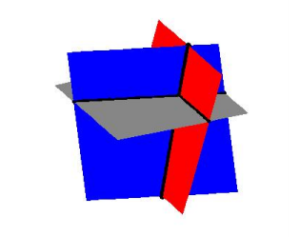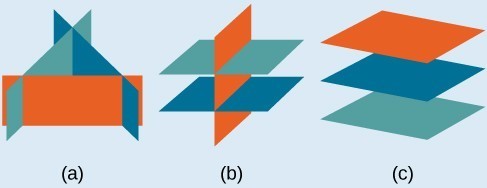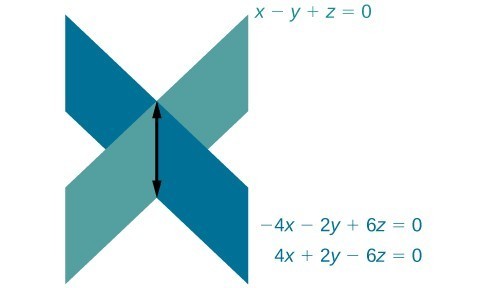Learning Objectives
- Introduction to systems in three variables
- Define the solution to a system of three equations in three variables
- Determine whether an ordered triple is a solution to a system
- Solve a systems of equations in three variables using elimination and back-substitution
- CLassify solutions to sustems in three variables
- Identify an inconsistent system of equations in three variables
- Identify a dependent system of equations in three variables
- Applications of systems in three variables
- Write a system of three equations with three unknowns given a business scenario
- Solve the system you define
The solution set to a system of three equations in three variables is an ordered triple [latex]\left(x,y,z\right)[/latex]. Graphically, the ordered triple defines the point that is the intersection of three planes in space. You can visualize such an intersection by imagining any corner in a rectangular room. A corner is defined by three planes: two adjoining walls and the floor (or ceiling). Any point where two walls and the floor meet represents the intersection of three planes.
Solution Set, One Solution
The figure below illustrates how a system with three variables can have one solution. Systems that have a single solution are those which result in a solution set consisting of an ordered triple [latex]\left(x,y,z\right)[/latex]. Graphically, the ordered triple defines a point that is the intersection of three planes in space.

In the first example, we will determine whether an ordered triple is a solution for a systems of three linear equations in three variables.
Example
Determine whether the ordered triple [latex]\left(3,-2,1\right)[/latex] is a solution to the system.
How To: Given a linear system of three equations, solve for three unknowns.
- Pick any pair of equations and solve for one variable.
- Pick another pair of equations and solve for the same variable.
- You have created a system of two equations in two unknowns. Solve the resulting two-by-two system.
- Back-substitute known variables into any one of the original equations and solve for the missing variable.
Solving a system with three variables is very similar to solving one with two variables. It is important to keep track of your work as the addition of one more equation can create more steps in the solution process.
In the example that follows we will solve the system by first using the elimination method to solve for x, then using back-substitution.
Example
Solve the system
[latex]\displaystyle\begin{cases}x-\frac{1}{3}y+\frac{1}{2}z=1\\\,\,\,\,\,\,\,\,\,\,\,\,\,\,y-\frac{1}{2}z=4\\\,\,\,\,\,\,\,\,\,\,\,\,\,\,\,\,\,\,\,\,\,\,\,\,\,\,z=-1\end{cases}[/latex]
Analysis of the solution:
Each of the lines in this system represents a plane (think about a sheet of paper). If you imagine three sheets of notebook paper each representing a portion of these planes, you will start to see the complexities involved in how three such planes can intersect. Below is a sketch of the three planes. It turns out that any two of these planes intersect in a line, so our intersection point is where all three of these lines meet.

Three Planes Intersecting.
In the following video we show another example of using back-substitution to solve a system in three variables.
In the next example, we will not start with a solution, but will need to use the method of elimination to find our first solution.
Example
Find a solution to the following system:
In the following videos we show more examples of the algebra you may encounter when solving systems with three variables.
Classify solutions to systems in three variables
Just as with systems of equations in two variables, we may come across an inconsistent system of equations in three variables, which means that it does not have a solution that satisfies all three equations. The equations could represent three parallel planes, two parallel planes and one intersecting plane, or three planes that intersect the other two but not at the same location. The process of elimination will result in a false statement, such as [latex]3=7[/latex] or some other contradiction.
Infinitely Many or No Solutions
- Systems that have an infinite number of solutions are those which, after elimination, result in an expression that is always true, such as [latex]0=0[/latex]. Graphically, an infinite number of solutions represents a line or coincident plane that serves as the intersection of three planes in space. The graphic below shows how three planes can intersect to form a line giving the system infinitely many solutions.

Infinitely many solutions.
- Systems that have no solution are those that, after elimination, result in a statement that is a contradiction, such as [latex]3=0[/latex]. Graphically, a system with no solution is represented by three planes with no point in common. Three parallel planes (c), two parallel planes and one intersecting plane (b), three planes that intersect the other two but not at the same location (a).

In the first example we will see how it is possible to have a system with three variables and no solutions.
Example
Solve the following system.
[latex]\begin{array}{ll}\text{ }x - 3y+z=4\,\,\,\,\,\,\,\,\,\,\,\,\left(1\right)\\ \,\,\,\,\,\,-y-4z=7\,\,\,\,\,\,\,\,\,\,\,\,\,\left(2\right)\,\,\,\,\\\,\,\,\,\,\,\,\,2y+8z=-12\,\,\,\,\,\,\,(3)\end{array}[/latex]
We will show another example of using elimination to solve a system in three variables that ends up having no solution in the following video.
We know from working with systems of equations in two variables that a dependent system of equations has an infinite number of solutions. The same is true for dependent systems of equations in three variables. An infinite number of solutions can result from several situations. The three planes could be the same, so that a solution to one equation will be the solution to the other two equations. All three equations could be different but they intersect on a line, which has infinite solutions. Or two of the equations could be the same and intersect the third on a line.
Example
Find the solution to the given system of three equations in three variables.
[latex]\begin{array}{rr}\hfill \text{ }2x+y - 3z=0& \hfill \left(1\right)\\ \hfill 4x+2y - 6z=0& \hfill \left(2\right)\\ \hfill \text{ }x-y+z=0& \hfill \left(3\right)\end{array}[/latex]
In our last video example we show a system that has an infinite number os solutions.
Applications
Systems can be helpful for solving real-world problems. In this example, we will write three equations that model sales at an art fair to learn how many prints should be sold to break even for the cost of the booth rental.
Example
Andrea sells photographs at art fairs. She prices the photos according to size: small photos cost $10, medium photos cost $15, and large photos cost $40. She usually sells as many small photos as medium and large photos combined. She also sells twice as many medium photos as large. A booth at the art fair costs $300.
If her sales go as usual, how many of each size photo must she sell to pay for the booth?
In the following video example we show how to define a system of three equations in three variables that represents a mixture needed by a chemist.
Our last example shows you how to write a system of three equations that represents ticket sales for a theater that has three different prices for tickets.
Summary
- The solution to a system of linear equations in three variables is an ordered triple in the form [latex](x,y,z)[/latex]
- Solutions can be verified using substitution and the order of operations
- Systems of three variables can be solved using the same techniques as we used to solve systems with two variables, including elimination and substitution.
- A system with three variables can have one, none, or many solutions
- A system with no solutions will have a non-true result when solving
- A system with many solutions will have an identity result when solving
Candela Citations
- Revision and Adaptation. Located at: http://Lumen%20Learning. License: CC BY: Attribution
- College Algebra: 8.1 Systems of Linear Equations: Gaussian Elimination. Authored by: Stitz, Carl and Zeager, Jeff. Located at: http://www.stitz-zeager.com/szca07042013.pdf. License: CC BY: Attribution
- Ex: Solve a System of 3 Equations with 3 Unknowns Using Back Substitution. Authored by: James Sousa (Mathispower4u.com) . Located at: https://youtu.be/HHIjTChrIxE. License: CC BY: Attribution
- Ex 2: System of Three Equations with Three Unknowns Using Elimination. Authored by: James Sousa (Mathispower4u.com) . Located at: https://youtu.be/r6htz3gaHZ0. License: CC BY: Attribution
- Ex 1: System of Three Equations with Three Unknowns Using Elimination. Authored by: James Sousa (Mathispower4u.com) . Located at: https://youtu.be/3RbVSvvRyeI. License: CC BY: Attribution
- Ex 4: System of Three Equations with Three Unknowns Using Elimination (No Solution). Authored by: James Sousa (Mathispower4u.com) . Located at: https://youtu.be/ryNQsWrUoJw. License: CC BY: Attribution
- Ex 5: System of Three Equations with Three Unknowns Using Elimination (Infinite Solutions). Authored by: James Sousa (Mathispower4u.com) . Located at: https://youtu.be/mThiwW8nYAU. License: Public Domain: No Known Copyright
- System of 3 Equations with 3 Unknowns Application - Concentration Problem. Authored by: James Sousa (Mathispower4u.com) . Located at: https://youtu.be/612Ad0W9ZeY. License: CC BY: Attribution
- System of 3 Equations with 3 Unknowns Application - Ticket Sales. Authored by: JAMES SOUSA (MATHISPOWER4U.COM) . Located at: https://youtu.be/Wg_v5R7BFo0. License: CC BY: Attribution
- Precalculus. Authored by: OpenStax College. Provided by: OpenStax. Located at: http://cnx.org/contents/fd53eae1-fa23-47c7-bb1b-972349835c3c@5.175:1/Preface. License: CC BY: Attribution
